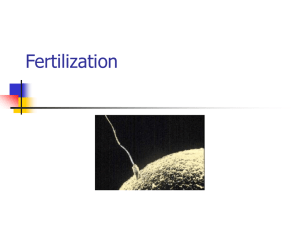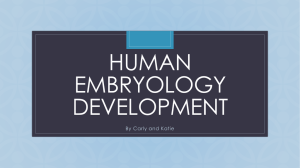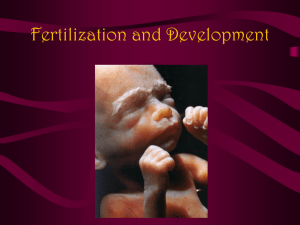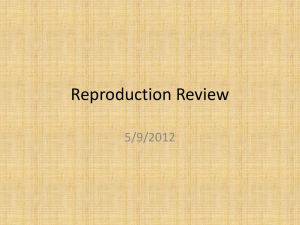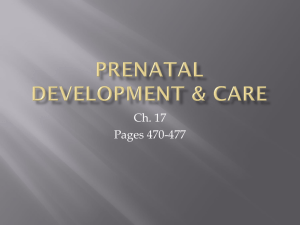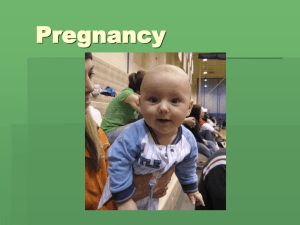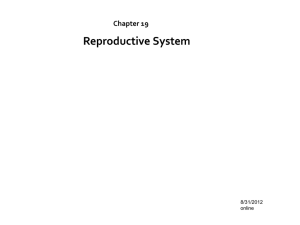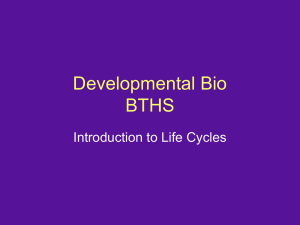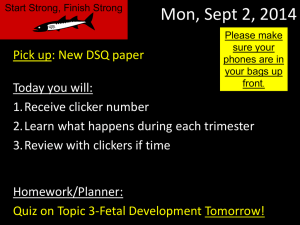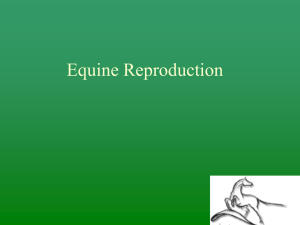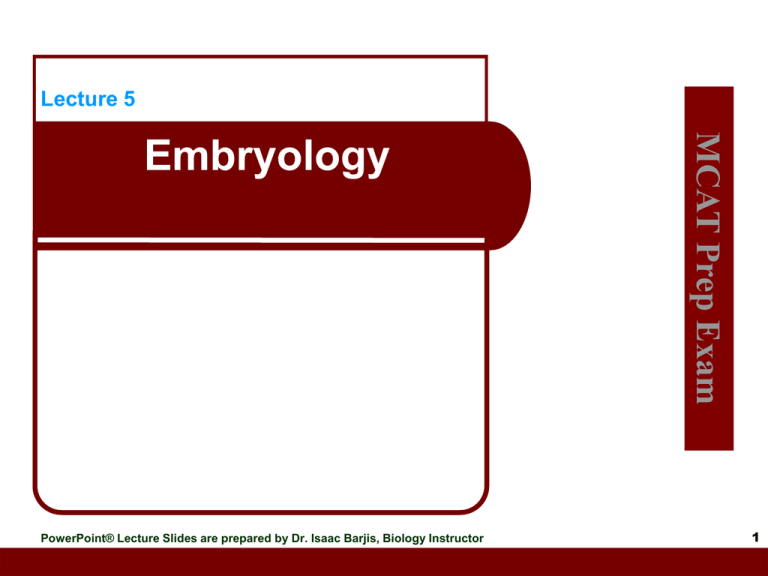
Lecture 5
PowerPoint® Lecture Slides are prepared by Dr. Isaac Barjis, Biology Instructor
MCAT Prep Exam
Embryology
1
Differentiation and development
Development involves:
1) Cell division and differentiation
2) Changes in anatomical structures
Differentiation is the creation of different types of cells
Anatomical changes include gradual modification of
physical and physiological characteristics
Development begins at fertilization
Stages of development
Development can be divided into: Prenatal and postnatal
development
Prenatal development begins at fertilization and ends with birth
Prenatal development includes:
Embryological development
Changes occurring during the first two months after
fertilization
Fetal development
Begins at the start of the ninth week and continues
until birth
Postnatal development
Commences at birth and continues to maturity
Fertilization (conception)
Fertilization is fusion of two haploid gametes
(egg and sperm) each with 23 chromosome
to produce a zygote that contains 46
chromosomes
Fertilization occurs in the uterine tubes
Within a day of ovulation
Spermatozoa cannot fertilize an ovum until
after capacitation
Fertilization Steps
• Step 1 Ovulation
• At ovulation the oocyte is in metaphase
of meiosis II
• Both the occyte and the polar body is
surrounded by corona radiate
• Step 2 Fertilization
• Oocyte is surrounded by the sperms
• Acrosomal enzyme from several sperms
creates gaps in corona radiata
• One sperm makes contact with the
oocyte membrane
• Sperm and oocyte fused
• The process of meiosis will
complete
Fertilization
The First Trimester
The first trimester is the period of
embryological and early fetal
development
Four processes occur during the first trimeter
1) Cleavage
2) Implantation
3) Placentation
4) Embryogenesis
The First Trimester
Cleavage
Cleavage - cleavage is the first cell division
The first cleavage occurs at 32 hours
Second cleavage occurs at 60 hour
Third cleavage occurs at 72 hours
Several divisions later the embryo becomes a solid mass of cells
known as morula
Molurla becomes a blastocyst (also known as blastula)
Blastocyte includes:
Trophoblast – outer layer of cells that give rise to the
chorion and placenta
Inner cell mass – cluster of cells at one end of blastocyst
Blastocoel – hallow fluid-filled inner cavity
Cleavage and Blastocyst Formation
The First Trimester
Implantation and Placentation
Implantation
Attachment of blastocyst into the uterine
endometrium
Occurs about 7 days after fertilization
Placentation
Blood vessels form around blastocyst and
placenta develops
The placenta is a complex organ that permits
exchange between the maternal and
embryonic circulatory systems
The uterus is prepared for implantation by the hormone
progesterone (see reproductive and endocrine lectures)
The First Trimester
Gastrulation
After implantation, cell migration transforms
blastula (single cell layer) to gastrula (3
layered structure)
Gastrulation is the generation of 3 distinct
germ (cell) layers
Endoderm
Mesoderm
Ectoderm
The Inner Cell Mass and Gastrulation
Germ layers
Gastrulation
By day 12 surface cells move toward the primitive streak
A third germ layer forms
The three germ layers are:
Ectoderm – superficial cells that did not migrate
Endoderm – cells facing the blastocoele
Will become integument (epidermis, hair, nail, epithelium, nose,
mouth and anal canal), lense of eye, ear and nervous system
Will become liver, pancreas, thyroid, bladder, lungs, epithelium of
digestive and respiratory systems.
Mesoderm – migrating cells between ectoderm and endoderm
Will become musculskeletal system, circulatory system, excretory
system, gonads, connective tissue of digestive and respiratory
systems, smooth and cardiac muscle.
Germ layers
14
Germ layers
Organs and glands are consist of or include
more than one germ layer
Adrenal cortex is derived from mesoderm
Adrenal medulla is derived from ectoderm
15
Neurulation
By the end of gastrulation, regions of the germ
layers begin to develop into a rudimentary
nervous system
Neurulation is the process of rudimentary
nervous system formation
Notochord – a rod of mesodermal cells that
develop along the axis.
Notochord cause ectoderm to bend inward and
form a groove
Ectoderms grow on either side of the groove and then
fuse together to form a neural tube
Neural tube becomes central nervous system (Brain and
spinal cord)
16
Fetal Respiration
Growing fetus receives oxygen and eliminates carbon
dioxide through a specialized circulatory system
The two components of this system are:
Placenta
Umbilical cord
Placenta and umbilical cord are outgrowths of the 4
extra-embryonic membrane (Amnion, Chorion, Allantois
and yolk sac) that are formed during the development
Chorion extends villi into uterine wall and these villi become
closely associated with endometrial cells
Chorionic villi forms intricate branching network for maternal
blood
Umbilical cord connects fetus to placenta
17
Extraembryonic Membranes
Four extraembryonic membranes:
Yolk sac
Amnion
Allantois
Chorion
Extraembryonic Membranes and
Placenta Formation
Extraembryonic Membranes and Placenta
Formation
Extraembryonic Membranes and
Placenta Formation
Embryo Anatomy
Yolk sac
Amnion
Encloses fluid that surrounds and cushions developing
embryo
Allantois
Important site of blood cell formation
Eventually becomes bladder
Chorion
Placenta formation begins for chorion
Chorion is a membrane that completely surrounds
amnion
A Three-Dimensional View of Placental
Structure
Hormones of the placenta
Trophoblast secretes hormones to maintain pregnancy
Human chorionic gonadotropin (hCG) – Prevents disintegration of corpus
luteum
Estrogens – in addition to having role in secondary sexual characteristics it
is involved in the thickening of the endometrium
Progesterone - enriches the uterus with a thick lining of blood vessels and
capillaries so that it can sustain the growing fetus
Human Placental Lactogen (hPL) - decreases maternal insulin sensitivity,
and therefore raises maternal blood glucose levels, whilst decreasing
maternal glucose utilization, which helps ensure adequate fetal nutrition
Placental prolactin- stimulates the mammary glands to produce milk
At the ovaries corpus luteum produce progesterone
Increased serum concentrations of prolactin during pregnancy cause enlargement of
the mammary glands of the breasts and increases the production of milk. However,
the high levels of progesterone during pregnancy stop ejection of milk.
After childbirth progesterone decreases and milk ejection initiates.
Relaxin
Second and Third Trimesters
Second trimester
Organ systems increase in complexity
Third trimester
Many organ systems become fully functional
Fetus undergoes largest weight change
At end of gestation fetus and uterus push
maternal organs out of position
The Second and Third Trimesters
Growth of the Uterus and Fetus
Growth of the Uterus and Fetus
Developing fetus totally dependent on
maternal organs
Maternal adaptations include increased
Respiratory rate
Tidal volume
Blood volume
Nutrient and vitamin uptake
Glomerular filtration rate
Structural and Functional Changes
in the Uterus
Progesterone inhibits uterine muscle
contraction
Opposed by estrogens, oxytocin and
prostaglandins
Multiple factors interact to produce labor
contractions in uterine wall
Factors Involved in the Initiation of
Labor and Delivery
Labor and Delivery
Goal of labor is parturition
Stages of labor
Dilation
Expulsion
The cervix dilates and fetus moves toward cervical
canal
The cervix completes dilation and fetus emerges
Placental
Ejection of the placenta

